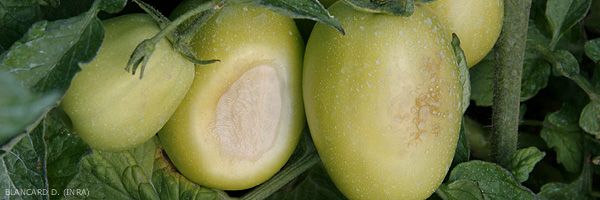
Sunburn of fruits
( sunscald , sun burn )
On green or rotating fruits, sun burns result in spots sometimes appearing on the side most exposed to direct sunlight, this during very hot climatic periods. These lesions are irregular, whitish in their center, and more or less surrounded by a yellow halo (Figures 1 to 3). They are slightly depressed, and their surface is more or less wrinkled and takes on a dry texture reminiscent of paper. Often superficial, they are sometimes invaded by various opportunistic fungi, in particular Alternaria alternata . In this case, a brownish to black mold gradually covers them.
This non-parasitic disease rather occurs in the open field, it can also be observed under shelter. It mainly affects varieties with sparse vegetation or crops with reduced vegetation; in the latter case, the foliage reduction can have different origins:
- severe attacks from one or more fungal airborne diseases, especially (alternaria, stemphyliosis, mildew, septoria ) or bacterial;
- leaf damage following the proliferation of pests or certain physiological diseases (for example physiological ; leaf roll leaf roll );
- too much leaf stripping;
- insufficient shade under shelter during particularly sunny and hot periods;
- the turning of the plants during the first harvest of tomatoes grown flat, etc.
The unripe fruits of field crops are particularly vulnerable. Their pericarp undergoes irreparable degradation under the effects of the local rise in tissue temperature as a result of solar radiation. Controlling these factors helps prevent sunburn. In order to protect the fruits, in certain cultural contexts, they may be covered with straw.
It should be noted that comparable symptoms can be observed in a greenhouse on certain fruits which inadvertently come into contact with the heating pipes (figure 4).





